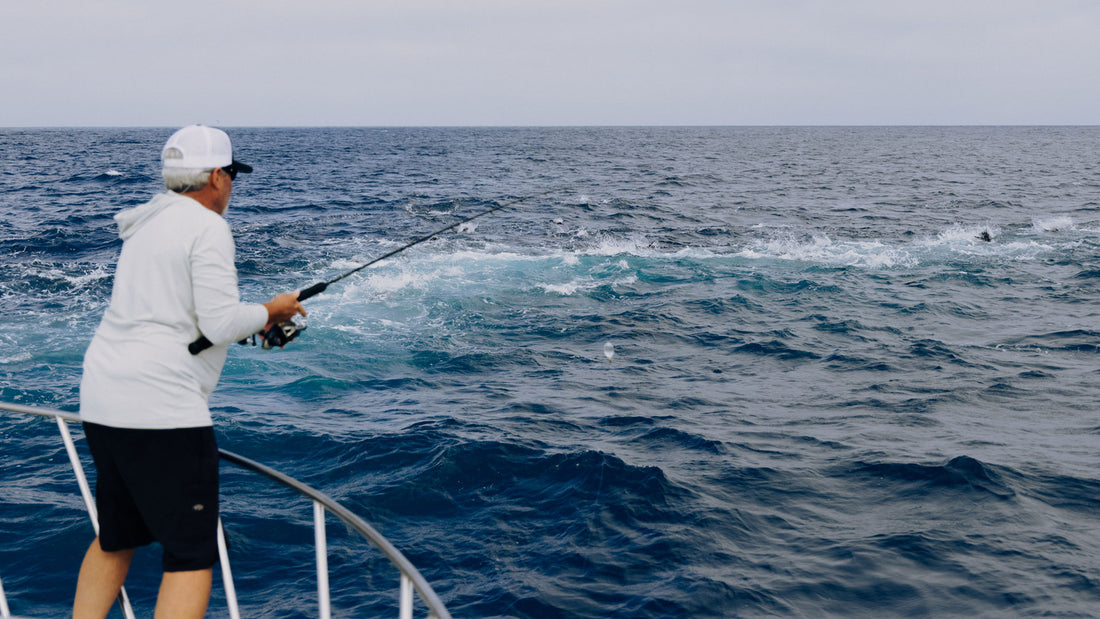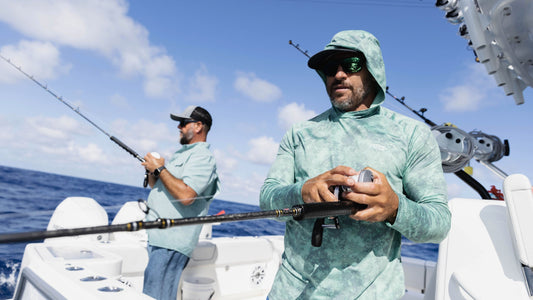
How to Catch Bluefin Tuna
Written By: John Flanagan
Bluefin Tuna symbolize everything we value in a trophy fish. Difficult to catch, wary, fast, large, and strong, landing a bluefin tuna poses unique challenges. Luckily, you can successfully pursue and land a bluefin with careful planning, attention to detail, and knowing their habits and movements.
This guide to bluefin tuna fishing will help you understand the various fishing methods and techniques to locate, hook, and land bluefin tuna.
Bluefin Tuna Species Overview
Bluefin, the largest of the tuna species, grow to enormous proportions. They can reach lengths of over ten feet and can weigh over 1000 pounds. The biggest bluefin tuna caught on rod and reel tipped the scales at a whopping 1496 pounds!
Bluefin tuna are comprised of three distinct species:
- The Pacific Bluefin (Thunnus orientalis)
- The Atlantic Bluefin (Thunnus thynnus)
- The Southern Bluefin (Thunnus maccoyii)
These highly migratory fish are found throughout the subtropical and temperate waters of the Pacific, Atlantic, and Indian Oceans. Opportunistic feeders prey mainly on small to medium-sized fish but also on squid, eels, and crustaceans.
As one of the few warm-blooded fish species, they can endure extreme temperature variations and dive to great depths. Being warm-blooded, bluefin need to swim constantly to keep a flow of water over their gills. These remarkable fish can reach speeds over forty miles per hour, hunt by sight, and eat up to ten percent of their body weight daily.
Unpredictable, adaptable to various water temperatures, and always on the move, they are relentless fighters with brute strength, resulting in long, grueling battles when hooked. For details about bluefin tuna, check out the bluefin species spotlight.

Techniques & Tackle
Techniques for catching Pacific Bluefin Tuna include trolling, kite fishing, and casting to actively feeding fish. Other methods include vertical jigging, using sinker rigs, and fly lining. Each fishing technique is effective at certain times and locations, and which technique to use is determined by the fish's behavior, the type of boat, and angling ability.
Trolling
High-speed trolling of bonita-style tuna lures is tremendously popular. Lures such as the Nomad Madmac or the Yo-Zuri Bonita pulled at 11 to 15 knots can be deadly. High-speed trolling allows the boat to cover a lot of water, which increases the likelihood of finding bluefin. It’s a relatively uncomplicated way to fish that doesn’t require a ton of specialized gear-making it ideal for less skilled anglers. A downside is that high-speed trolling burns much more fuel than trolling at traditional speeds.
Trolling a spreader bar at 7 to 8 knots is another choice. A spreader bar consists of a gang of lures held apart by a stiff wire or composite bar that forms a small “school” of bait skittering on the surface. The bait furthest back in the school is larger than the others and is the only bait with a hook. The assembly creates a surface commotion that can provoke bluefin to strike. Spreader bars are large and challenging to deploy, especially in rough seas. Fighting a large fish with the spreader bar on the line is cumbersome, but this is a proven method of catching bluefin tuna. Slow-trolling live baits such as sardines can also be successful.

Trolling tackle for bluefin tuna is based on the fish size being targeted. For larger class fish, a 50-wide reel spooled with 80-to-100-pound test braid, a top shot of 100 feet of 100-pound test monofilament, or fluorocarbon leader on a 7-foot rod rated for 80 to 130 pounds is recommended to handle these brutes. Reels need to be heavy-duty with lever drags and two-speed retrieves. Good choices for reels are the Okuma Makaira 50W, the Avet TRX 50, or the Shimano Talica 50 II.
Trolling gear can be downsized if fish are prevalent in the 20-to 60-pound range. A 25- or 30-size two-speed lever drag reel such as the Penn Fathom 30 paired with a 7-foot rod rated for 30 to 80 pounds with 65-pound test braid and 50-pound test fluorocarbon leader will suffice.
Kite Fishing
Kite fishing can be effective when bluefin are incredibly finicky. The kite setup works like an outrigger; the fishing line is clipped to the kite, allowing the bait to be held on the water's surface and away from the boat. When a fish inhales the bait, the clip releases the line from the kite, and the angler fights the fish. When there isn't enough wind to keep the kite aloft, a helium balloon is attached to the kite to keep it airborne. The captain can "troll" the fishing kite to position the bait in the desired spot.
A dead-rigged flying fish is the most common bait for kite fishing, but artificial flying fish are gaining popularity. The bait's action on the water's surface mimics the natural movements of flying fish that tuna find irresistible. The kite keeps the leader and line out of the water, creating a life-like presentation. It is common for tuna to attack the bait aggressively. It is fascinating and something that an angler will remember.

Kite Fishing Tackle
Kite fishing tackle requires two rod and reel setups, one for the kite and the other for fishing. Kite fishing for Pacific bluefin often means going after 200-pound-plus fish referred to as “cows.” To wrestle these fish, tuna reels are 50 wide two-speed lever drags and spooled with 130-pound test braid with a heavy monofilament top shot. Stand-up rods should be 5 to 6 feet, curved-butt, and matched to the line weight.
The kite is attached to a short rod and an electric reel. Specialty kite rods and reels make handling the kite easy, but they are optional; the kite setup should be capable of handling a 65-pound test braid.
Casting to Feeding Bluefin
Casting to feeding bluefin tuna that are crashing baitfish on the surface is one of the most exhilarating experiences in fishing. When one of these “foamers” is spotted, approach the school slowly until you get in casting range.
Start by casting surface poppers into the school. Good choices are the Halco Roosta or Yo-Zuri Mag Popper. Surface stick baits like the Nomad Dartwing are also effective. If the surface lures fail to draw a strike, change to a sub-surface bait such as a Madscad. If you don’t succeed with these lures, switch to a Salas 7X surface iron or something similar. If these fail, heave a flat fall jig into the foam and let it sink. The falling action mimics a wounded baitfish that sometimes elicits a strike when surface baits won’t.

Tackle For Casting to Feeding Bluefin
Tackle for casting to feeding bluefin can be either conventional or spinning gear. Anglers that prefer conventional tackle can utilize a 30 to 80-pound rated rod, 8 to 9 feet long, with a 40-sized reel topped with 50-pound monofilament or fluoro. For a spinning setup, a 5500 reel on an 8 to 8 ½ foot rod spooled with a 65-pound test braid and a 60-pound test leader will work. If larger bluefin tuna are present, use the same spinning setup with an 80-pound test braid line and a 100-pound test leader.
Regardless of the fishing method, your gear must be in top condition to fight these heavyweights and get them into the boat. Any weakness will result in a lost fish. Hoisting these giants over the rail means working as a team and using the right gaff. Check out the How to Choose a Gaff blog to learn more.
Location & Seasons for Pacific Bluefin Tuna Fishing
Pacific Bluefin Tuna migrate from south to north along the continental shelf from Baja Mexico up the California coast. Prime fishing occurs from June to September. These bluefin congregate along currents, eddies, and temperature breaks created by undersea mounts, ridges, and islands. They travel along these areas searching for schools of anchovies, mackerel, flying fish, and other forage.
The areas with significant undersea structure, currents, and temperature breaks are where you want to fish. Notable productive areas include:
- Southern California: Cortes Bank, Tanner Bank, the 43 Fathom Spot, Desperation Reef, Pilgrim Bank, and the 209.
- Bay Area California: Cordell Bank and the Farallon Islands approximately 40 miles west of the Golden Gate Bridge.
- Mexico: Butterfly, 60 Mile Bank, Mushroom, the 425, and the Hidden Bank.
Approaching the tuna grounds, it is important to look for signs of birds and disturbed water. A school of bluefin tuna feeding on the surface creates a sea of whitewater with birds diving, baitfish scattering, and bluefin knifing through the bait, creating a foam on the surface. When this action occurs, there are often “breezer” bluefin nearby. These bluefin tuna swim just below the ocean surface, creating ripples resembling a gust of wind. These fish can be especially receptive to taking bait. In this situation, you can troll the area, cast directly to the fish, deploy a kite, or choose another fishing method.
Keeping a close watch on the sonar while on the tuna grounds is crucial for anglers. This may be your only way of knowing that bluefin are in the area. If the bluefin stay deep but are visible on sonar, you may be able to get hook-ups trolling, but fishing with sinker rigs and vertical jigs is often the best bet.
Pacific Bluefin Tuna Limits & Regulations
Our duty as anglers is to fish responsibly to ensure the sustainability of bluefin tuna stocks. Respecting regulations and keeping no more tuna than you need goes a long way toward ensuring the fishery's survival. Double-check local and federal fishing limits and restrictions to stay current with them.
Captains and crew on charter, long-range, and local guide boats will be well-versed in the regulations. If you're fishing from a private boat, beyond being familiar with the regulations, you need to be able to identify the different tuna species that look remarkably similar, especially when small.
As of June 2024, Pacific Bluefin Tuna limits are:
California: Two fish per day per person with no size limit.
Mexico: Two fish per day per person with no size limit. Mexico has a point system for saltwater fish. Currently, two bluefin tuna hit the maximum number of points allowed per angler per day. All non-residents fishing in Mexican waters need to purchase a license!
Bluefin tuna are one of the strongest, most majestic, and sought-after fish, and rightfully so. Using these tactics and methods, you can successfully locate, hook, and land this fantastic fish. Check out the Year of the Bluefin film to see bluefin in action.
Author's Profile: John Flanagan
John Flanagan writes about fishing, boating, business, and coastal lifestyle. A life-long fisherman, licensed captain and aficionado of all things coastal, he pursues his passions on the coastal waters of North Carolina. Learn more here.






